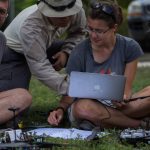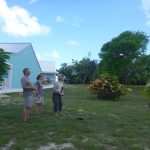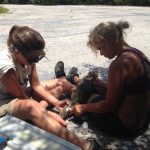Tracking Iguanas from the Sky: Drone research in the Cayman Islands
San Diego, Calif., Nov. 2, 2016 — To get a closer look at lizards on the ground, researchers at the University of California San Diego Qualcomm Institute are taking to the skies.
The QI team is part of a collaborative effort — along with researchers at San Diego Zoo Institute for Conservation Research, Mississippi State University, and Cayman Islands Department of Environment — to use drones to track the nesting movements of critically endangered iguanas. At 30 to 40 inches long, the Sister Islands Rock Iguana (or Lesser Caymans Iguana) is one of the world’s largest iguana species. Although the lizards are indigenous to Cayman Brac and Little Cayman (together called the Sister Islands, because of their similar shape and size), predation from introduced mammals, road mortalities and habitat loss from human development have eliminated all but 1,500 iguanas from the islands, making the species critically endangered.
Partnering in the project are three UC San Diego researchers from Engineers for Exploration (E4E), a program that enlists students to build technologies to help scientists, conservationists and explorers; Computer Science and Engineering (CSE) Professor and E4E Co-Director Ryan Kastner; Qualcomm Institute (QI) Manager and E4E Co-Director Curt Schurgers; and Electrical and Computer Engineering (ECE) student Nathan Hui (B.S. ‘17), who is a project lead in E4E. San Diego Zoo Caribbean Program Head Glenn Gerber and Mississippi State biology professor Mark Welch (along with his Ph.D. student, Jen Moss) lead the research team, with support from the Cayman Department of the Environment.
Hui, who led the development of the entire drone system, was recently enlisted to train Moss, Gerber and their colleagues to use drone technology to continue their ongoing work tracking the iguanas and to make the process more efficient. Drones were especially needed on this project because of the terrain of the Cayman Islands.
“The iguanas are difficult to track on foot,” said Hui. “Most of the island is mangrove swamps. Just one kilometer takes around four hours to walk.”
Scientists searched nesting sites on foot to find 20 female iguanas, then glued radio transmitters to their tails. For the span of about two weeks, the transmitters (which are about the size of hearing aids and weigh only 2 grams) emit a high frequency ping, or beep, which is detectable by the specially-equipped drones. Each transmitter puts out a different frequency ping so researchers can tell individual animals apart.
In reference to the radio-tracking drone technology, San Diego Zoo’s Gerber said, “it’s surprising no one’s developed something like this before.”
The drones (only one of which was flown, with the other used for backup) are autonomous once in the air and only require human control during takeoff and landing.
Once at their cruising altitude of 30 meters, the drones fly in a “lawnmower pattern,” searching for the radio transmitters attached to the iguanas.
“The nice thing is you’re not just looking for one signal at a time,” said Schurgers. “If all of the iguanas are in the area at once, then the drone can detect them all.”
The drones’ detection range is approximately 30 meters, which Kastner describes as “just barely enough to pick up the signal, otherwise you have to fly lower, which means there’s more risk with any topography change.”
Hui was tasked with travelling to Little Cayman for 10 days to teach the researchers about drone technology so they could operate the quadcopter drones after he returned home. He trained the researchers how to fly the quadcopters and how to detect if the drones were experiencing problems. He even wrote a flight manual for the machines.
Hui said that it was important for the researchers to spend most of their time focusing on their research. “We underestimated how little time scientists wanted to spend setting up the drones,” Hui said. “I found that these scientists are more pressed for time and not as familiar with the technology.”
Once he returned to California, Hui continued to work on the project by answering emails Moss sent whenever the drones crashed.
“He was like a remote help desk,” Schurgers said.
The research is part of an ongoing collaboration between E4E and the San Diego Zoo, and the team’s trip to the Cayman Islands marks the second time E4E researchers have taken drones to a tropical island. Last summer Hui travelled to the Dominican Republic to test drones’ tracking abilities and educate researchers about the systems.
While in the Dominican Republic, the E4E team had much more difficulty locating transmitted subjects because the drone’s receiver wasn’t powerful or sensitive enough.
According to Hui, the researchers used what they learned last summer to make this year’s project in the Caymans go more seamlessly by using radio transmitters that emitted stronger signals, and simplifying operation of the drones.
“The scientists want something that works right out of the box,” Schurgers noted, “and they have to be able to trust it.”
Both drones were custom-built by E4E students in San Diego with funding from Behavioral Ecology Division of the San Diego Zoo. “Our next step is to improve drone detection range further,” Schurgers said.
“The technology can be easily adapted to fit another transmitting device,” Kastner said. “Including animals that use larger collars.” This makes it easier than the relatively small iguana collars as then they can transmit with more power.
After the research is completed the radio transmitters generally fall off the iguanas because they shed their skin. Mississippi State’s Moss nevertheless recaptured 10 of the iguanas after tracking them back to their nesting sites and manually removed the transmitters so they could be reused in future research.
With the help of drone technology, the scientists are on their way to answering two key research questions concerning the iguana’s communal nesting sites: where do the females come from to lay eggs at the nesting sites? And where do the juveniles disperse to after hatching?
“The tracking data collected so far have shown us that females sometime live far from their nesting sites and may pass several other nesting sites en route to theirs,” Gerber said.
One possible explanation for this is that females return to the nesting site where they were born to lay their own eggs. The researchers plan to return to Little Cayman next summer to study the dispersal of juvenile iguanas from nesting sites after hatching.
IMAGES:
Sister Islands Rock Iguana
Gerber and Moss join Hui for a test flight of the drone.
UC San Diego ECE student Nathan Hui (in hat) instructs San Diego Zoo Caribbean Program Head Glenn Gerber (at left) and Jen Moss on how to operate the drone.
Jen Moss (left), a Ph.D. student in biology at Mississippi State University, attaches a radio transmitter to the tail of an iguana.
For more on this story go to: http://www.calit2.net/newsroom/article.php?id=2773









